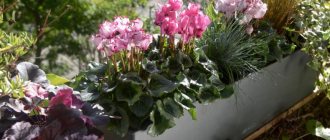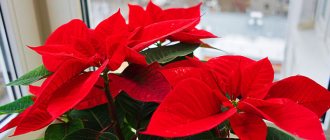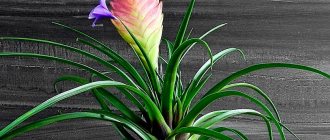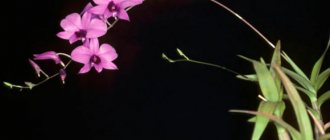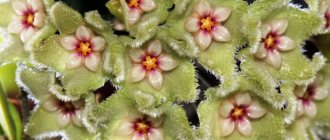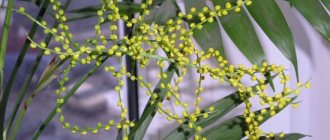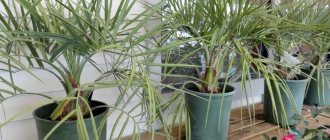Description and origin
Aspidistra is a perennial herbaceous plant from the Asparagus genus. In the wild, the aspidistra plant grows in the subtropical forests of East Asia, in particular in Southern China, Japan and Taiwan. For home cultivation, only one type of plant is used - Aspidistra elatior Variegata or Aspidistra high.
The description of the flower is quite simple: the plant has no stem, the leaves grow on long petioles immediately from powerful tap-shaped roots. The leaves themselves are oval, dense, glossy, rich dark green. The plant reaches a height of 50-70 cm.
The flowering of this plant is an extremely rare occurrence. Aspidistra flowers appear in the summer and last only one day. Small, dirty purple flowers appear close to the ground and often go unnoticed due to the large leaves.
Types and varieties of aspidistra with photos and names
Aspidistra tall (Elatior)
The name of this species is due to the fact that the bush is relatively large in size. Under natural conditions, it can reach a height of about 0.8 meters. When grown indoors, the height of such a flower, as a rule, varies from 0.6 to 0.7 m. The length of the leaf plates is about 0.3–0.5 m, and their width is 0.1–0.15 m, they have an oblong-pointed shape (outwardly similar to “sharp tongues”). Their surface is glossy and their color is green. Over time, the bush grows, becomes dense and somewhat similar to a lush fountain. This species is characterized by extremely slow development. Within 12 months, only 3–5 new leaf blades grow on the bush. When grown indoors, flowering occurs very rarely and only in the summer. Small purple-red flowers are formed on the bush, reaching no more than 30 mm in diameter.
Aspidistra Milky Way
Such an evergreen plant can reach a height of 0.4 to 0.6 m. If the growth of foliage is not limited, the shrub can become dense and large in diameter. This plant is highly drought-resistant and can withstand not very cold temperatures. The surface of the long, hard leaf blades is decorated with a large number of creamy spots. Such dots look like small stars, which can’t be counted in the sky. This coloration was the reason for choosing this particular name for this species, the fact is that “Milky Way” is translated as “Milky Way”. This plant, like other aspidistras, is slow-growing, and it also blooms quite rarely. When grown indoors, flowering is observed in the last winter or first spring weeks. Small purple flowers with sharp petals grow on the bush.
Aspidistra variegata
This species reaches a height of about half a meter. Over time, it can grow greatly, resulting in a dense shrub. It differs from other species in that it is more demanding in care; for normal growth and development, it must be provided with an optimal level of lighting and humidity, as well as timely feeding. Dark green leaf blades are decorated with vertically arranged cream stripes. If you keep the plant incorrectly, these same stripes may disappear. This happens due to excessively high humidity of the substrate in the pot or as a result of excess fertilizing.
Aspidistra bloome
The large glossy leaf blades of this perennial are dark green. Their shape is similar to the foliage of the lily of the valley, but they are much larger, so they reach about 50 centimeters in length and up to 15 centimeters in width. It is distinguished by rare flowering. A flower is formed at the very rhizome. The bud has 8 petals, colored crimson or yellow.
Aspidistra attenuata
This evergreen plant's leaf blades have long petioles (up to 30 centimeters), and their length can reach up to half a meter. There are many small white spots on their surface. This species, like many others, is characterized by its low maintenance requirements. It is very hardy and therefore grows well in cool climates in places with polluted air. Over time, the bush grows and becomes lush. A small purple flower grows at the base of the rhizome once a year in the first weeks of summer. After the bud opens, the flower reaches about 30 mm in diameter.
Aspidistra grandiflora
This species was discovered relatively recently. This plant is becoming more and more popular with gardeners every year. Its distinctive features are large flowers and long (about 0.8 m) oval leaf blades. It also differs from other species in that it does not form a lush shrub over time. In indoor conditions, the bush rarely blooms; as a rule, this happens in the middle of summer. 3–5 buds are formed on the main root, and dark purple flowers appear from them. After the bud opens, the flower reaches up to 50 mm in diameter. The unusually shaped long petals are similar in appearance to spider legs.
Aspidistra sichuan
In nature, the species can be found in China in bamboo forests at an altitude of 700 meters above sea level. In these places, this aspidistra prefers to grow in the fields; it covers the entire territory with its lush leaves. When grown indoors, the bush also becomes a dense shrub over time. It has oval straight leaf plates, the length of which is about 30 centimeters and the width is up to 8 centimeters. The surface of the foliage is decorated with arched longitudinal white stripes. The bush blooms in spring. One bud forms on the main root, and a small dark purple flower appears from it.
Aspidistra oblancephalia
The leaf blades of this species are green and narrow (no more than 30 mm wide). It has varieties whose foliage has patches of yellow. The total height of the bush is about 0.6 m. During flowering, this species produces small red star-shaped flowers, their opening begins in the first weeks of spring.
Aspidistra guangzhou
This species differs from others in that its short (up to 20 centimeters long) leaf blades have long petioles, the height of which is about 40 centimeters. There are yellowish spots on the surface of the dense and wide leaf blades. Flowering begins in May, at which time paired buds form on thin roots, and then large flowers appear from them, very similar to those formed in Aspidistra grandiflora. Opened flowers are violet or purple in color.
Care
Caring for aspidistra at home does not require any special skills. The main thing is to maintain conditions close to natural for the plant.
How to care
Aspidistra plant care at home - this is one of the few that can grow where other plants practically cannot grow. When grown, you can watch the aspidistra bloom. Such factors as temperature changes in the room, lack of lighting, dry soil and minimal care. Aspidistra is a godsend for such premises.
- The soil. It should be quite heavy and dense. The composition of such a soil mixture should include several components: equal parts of turf, compost or humus soil and sand. For a simple aspidistra, you can use soil from the garden or vegetable garden. Or purchase ready-made soil in specialized stores. But for forms with variegated foliage, the soil should be much more nutritious and loose.
- Landing. Be sure to place expanded clay in the prepared container. Add some soil. Place the plant in the pot so that it is at the same level as before planting. Add soil and gently compact it. Water generously.
- Transfer. Very critical to transplantation. We do it only when there is really a need for it. If you need to replant a plant, the best time of year is spring, from March to May. Renewing the top layer of soil can be done every year. This is done very carefully. The main thing is not to damage the roots. Since even the smallest roots are damaged, the plant can suffer from illness for a long time and eventually die. For new transplanted plants, a prerequisite is drainage and a small pot or container. For a good and decorative appearance, it is enough to replant it once every four years.
- after you have carefully pulled out the earthen lump. We take a sharp knife and cut off part of the earthen clod (the lower part) no more than three centimeters. We do this carefully so as not to damage the remaining roots.
- For replanting, take a larger pot, put drainage and a little nutritious soil on top. Next, we place the plant and fill it with the remaining soil to the desired level. Gently tamp down the soil.
- We water the plant abundantly, this will allow the soil to come into contact with the roots, this way the soil will settle and, if necessary, you can add more. We remove excess moisture from the pallet.
Temperature
Aspidistra prefers low temperatures of about 20°C in summer and 15-18°C in winter. The plant adapts much better to cold than to heat: at 10°C its vegetation phase actively begins, and at 25-30° the leaves begin to yellow and die.
Flower transplant
From time to time, all plants need to be replanted, as they outgrow their old “home” (pot) and require “moving to a new, more spacious home.” Flower growers advise replanting the plant in April, every 3-4 years. For replanting, prepare a new pot, larger than the current one, and place drainage at the bottom.
The plant itself is carefully removed along with the soil and placed all together in a new pot, then as much soil is added around as needed to fill the vessel. After filling the flowerpot, the soil should be lightly pressed down and watered.
Lighting
Aspidistra elatior naturally grows in the lower layer of subtropical forest, so it is perfectly adapted to partial shade. However, it cannot do without sunlight at all - the leaves begin to turn pale and the plant slowly dies.
It is best to place the flower pot on a western windowsill or curtain the window so that diffused light falls on the leaves.
3.Types of aspidistra:
3.1.High aspidistra or elatior - Aspidistra elatior
An evergreen herbaceous perennial houseplant native to Japan and China. The leaves are glossy, dark green, pointed, up to 60 cm long, on short basal petioles. The flowers are hidden in the foliage, on short and strong peduncles.
↑ Up,
3.2.Aspidistra Variegata
An attractive ornamental foliage plant with large, green leaves with numerous longitudinal white or light green stripes. The variegated species reaches a height of 50 cm.
↑ Up,
Watering
The plant is not at all picky when it comes to watering. It is best to wet the earthen ball well 1-3 times a week so that it is moist, but not too wet. A single overfill or underfill will have absolutely no effect on the aspidistra.
The plant practically does not require spraying, except on hot days. It is much more useful to wipe the leaves from dust with a damp cloth.
Despite the ease of caring for aspidistra indoors, it is better to pre-prepare the water for irrigation:
- The ideal water for watering flowers is rainwater;
- Water for flowers should be at room temperature - too cold or hot water can damage the roots and cause them to rot;
- Tap water must be left in an open container for at least 2 hours; this will reduce the concentration of chlorine;
- If possible, it is necessary to acquire a household filter that reduces water hardness - this will protect the plant from white coating on the leaves and damage to the root system.
Seasonal flower care at home - table
| Season | Temperature | Humidity | Lighting |
| Spring | The undemanding aspidistra grows well in a standard apartment with its temperature conditions. But if you want to create comfortable conditions for the plant, then in summer you need to keep the flower at an average temperature of 22°C. If the thermometer shows 30°C, then the aspidistra will pass this test, although the leaves may begin to turn yellow. | Aspidistra tolerates dry air well. Summer temperature increases can be smoothed out by spraying. It is also good to arrange sanitary days for the aspidistra, wiping the leaves from dust with a damp cloth or bathing it in the shower. | Aspidistra is a very shade-tolerant plant, so light partial shade is the ideal level of light. Usually grows near a north window. The south side should be avoided. Sun rays are harmful to aspidistra leaves. In the depths of the room, it is necessary to provide additional lighting, especially in winter, for at least 16 hours, primarily this applies to variegated forms. |
| Summer | |||
| Autumn | The acceptable winter temperature is within 16°C, but not lower than 10°C. Aspidistra with variegated leaves requires a temperature a couple of degrees higher. | In winter, when kept in a heated room, spraying is necessary. | |
| Winter |
Trimming
To ensure that the plant does not lose its decorative properties and looks like aspidistras in the photos of professional gardeners, it is necessary to prune it correctly and on time. It is necessary to remove withered and damaged leaves in a timely manner - they not only spoil the overall appearance of the flower, but also take a lot of energy and nutrients.
The leaves should be cut with a sharp, clean knife close to the ground, after which the cut must be treated with crushed coal. This pruning stimulates the aspidistra to produce new leaves.
Description of the aspidistra plant
Aspidistra belongs to the Asparagus family (Asparagaceae).
Only one species is kept as a houseplant - Tall Aspidistra (Aspidistra elatior). Various varieties have been bred on the basis of this species, but only one is found on the shelves of flower shops and home window sills - Variegata. This variety of aspidistra has become very popular due to its spectacular coloring. The leaves of this plant are decorated with longitudinal stripes, which are randomly placed on a green background, and have color transitions from white to beige.
The domestic aspidistra has received several nicknames in everyday life: “cast iron plant” for its unpretentiousness, and “Asian lily of the valley” for the shape of its leaves.
Aspidistra is a perennial plant with a very impressive lifespan. With minimal attention and care, it can live for several decades.
In 12 months, aspidistra produces only 5 leaves. It grows very slowly, but over time reaches a respectable size - up to 75 cm. The main color of the leaves is dark green, permeated with cream veins. The leaves themselves sit on tall petioles (legs) and have an elongated, oval shape. The leaves reach 15 cm in width.
The roots of aspidistra have a very interesting appearance; they resemble crawling gray snakes.
During the winter months the plant begins to bloom. But the flowering phase, unfortunately, does not please with beautiful buds, and if you do not monitor the plant, it goes unnoticed. The flowering period is the appearance of small purple flowers at the base of the stem closer to the rhizome. These flowers seem to lie on the ground.
As a rule, they try to remove flowers immediately so that they do not interfere with the plant. But if you set a goal and carry out artificial pollination, then from the flowers you can get quite large berries, similar in appearance to a pear.
Transfer
This houseplant reacts very negatively to transplants due to the fragility of the roots, so they should be carried out only when absolutely necessary and with extreme caution.
It is better to carry out transplantation no more often than every 3 years. The plant tolerates replanting most easily in April.
The pot for the plant must be large, wide and deep in order to accommodate a powerful layer of drainage in addition to the plant.
It is not at all necessary for the plant to buy or make a special soil yourself - aspidistra feels great in universal soil or soil for garden seedlings.
Aspidistra is transplanted using the transfer method, that is, while preserving the earthen coma - the soil is simply poured into a new, larger pot. This gentle method of replanting a plant leads to the least damage to the root system.
Home care - about temperature and more
Watering
Aspidistra tolerates a lack of moisture in the soil more easily than with excessive watering. Moisturizing the substrate should be regular but moderate. The next watering is carried out after lightly drying the earthen clod by 1/3.
It is best to place the aspidistra pot on a small stand. This will prevent overcooling of the root system during the cold period.
In winter, water after the soil is half dry. But do not allow the earthen clod to dry out. The frequency of watering directly depends on the ambient temperature. If the room is cool, then you need to moisten the soil very carefully.
Watering is carried out with soft water at room temperature. Standing water before use is a mandatory procedure. The salts and minerals it contains can accumulate in the soil and enter the soft tissue of the aspidistra, causing growth retardation and other problems.
Fertilizers
I feed the plant from March to September. Universal fertilizers with an increased presence of nitrogen are used . Application frequency: 1 time per month.
Rooting a leaf
To implement this method, it is necessary to cut a leaf with a 7-8 cm cutting and immerse it in water. The neck of the container with water must be covered with cling film to prevent air circulation.
After the roots appear, the young plant needs to be planted in a separate pot and covered with a transparent plastic bag on top - in such an improvised greenhouse the plant will take root much faster.
Propagation by dividing rhizomes
The plant, although unpretentious, tolerates transplantation and division very painfully. To minimize injury, planting should be done in early spring. To do this, you need to remove the flower from the pot, carefully remove the excess soil with your hands, then use a sharp knife to separate part of the root system in one motion, so that 4-6 leaves remain on the top.
The resulting seedlings are planted in pots so that the roots do not begin to rot; they are sprinkled with wood ash before planting. At first, the sprouts need to be provided with moderate watering and a temperature around +20 degrees.
Growing from seeds
This method is the most complex of those listed and is used mainly by breeders to breed plants with new traits. It is not easy to obtain aspidistra seeds - the plant blooms for only one day, during which the flower must be pollinated and begin to set fruit.
Plant seeds should be sown in warm soil in early spring and planted after germination.
Description
Aspidistra is popularly called snake grass because the scaly, curved rhizomes protruding from the ground look like the body of a snake. The basal leaves, devoid of stems, grow extremely densely and tightly together.
Due to its visual similarity and lack of bulbs, this crop has long been considered a relative of lily of the valley and asparagus. The leaf blades of this flower are leathery, dark green, shiny, but larger and taller than the lily of the valley.
How does it bloom?
Aspidistra blooms rarely and sporadically. In indoor conditions, this happens most often in winter or early spring. Star-shaped axillary small (up to 2.5 cm) sessile flowers of purple or lilac color appear between the scales directly from the rhizome.
After pollination, a pear-shaped or round fruit is formed with a single large seed inside.
Signs and superstitions
A number of signs and superstitions are associated with aspidistra. It is believed that a flower received as a gift strengthens character and strengthens willpower, and also helps overcome despondency and treats depression. A bush growing in the house gives the owner stamina and endurance.
In addition to its magical qualities, the beneficial properties of aspidistra are also used. All parts of the plant (rhizomes, flowers and leaves) have healing properties.
Decoctions of this herb are used for urolithiasis, cystitis, gastrointestinal pathologies, muscle pain and cramps.
Diseases and pests
When purchasing a new plant, you should quarantine it - for at least a month it should stand separately from other plants (preferably in another room) in order to avoid the transfer of diseases and pests to the existing collection.
The plant should be carefully inspected daily for diseases and pest damage.
Wilting plant leaves can indicate several problems with the plant. If the leaves wither along their entire length, then most likely the temperature regime and low humidity are not suitable for the plant. Regular ventilation of the room and spraying aspidistra will help solve the problem.
If yellowing affects individual leaves, then the culprit is frequent overwatering, which led to rotting of the roots, or irregular pruning of old leaves. Also, rotting of the roots is indicated by the withering of the petioles at their very base.
The paleness of the leaf blades indicates a lack of light.
Brown, thin spots on the leaves are sunburn.
Brown patterns on leaf blades are the main sign of the appearance of spider mites. Small cobwebs may also appear on the plant. Ticks should be controlled using insecticides.
Curling and yellowing of aspidistra leaves is associated with aphid infestation. Treatment with insecticides and destruction of affected leaves will help against parasites.
Infection with scale insects leads to sudden yellowing and falling of leaves. Pests look like brown plaques on the plant. Since the shell protects the adult individuals of these pests from insecticides, it is necessary to remove uninvited guests manually, using a cotton pad soaked in a soap solution.
Afterwards, the plant itself, the pot and the surface on which the affected flower stood should be treated with an insecticide against young parasites. It is advisable to inspect and treat all plants in the house to prevent the spread of parasites.
Signs of insufficient care for aspidistra
A plant in captivity, even the most unpretentious one, requires care. When caring, you should take a closer look at the flower, and it will tell you about the problems:
- slow growth - feed with urea;
- dark spots - inspect for pests, remove from drafts, increase the temperature;
- dry tips of leaves - dry air, dry soil;
- limp, blackening leaves - the plant has been flooded;
- leaves turn yellow - the plant is old or the roots are rotting.
Like all other household inhabitants, aspidastra, if not properly cared for, is susceptible to infestation by spider mites, aphids and scale insects. You can control these pests with the help of chemicals, but you need to remember to take protective measures for yourself and others.
Aspidistra Photos
Aspidistra transplant
Due to the fact that this crop can be grown in almost any type of soil, it can even be replanted into soil taken from the garden. But if you want to get a beautiful, bright shrub, it is best to buy a universal soil mixture at a garden store. This soil has the entire range of nutrients that your flower will need. You can also prepare the soil mixture yourself by mixing turf, humus, leaf soil and river sand in equal proportions. During the replanting process, you should be aware that the flower has very fragile root processes that easily break off and become damaged. Therefore, it is best to replant by transshipment, without destroying the earthen ball and without damaging the root shoots. The procedure is carried out in early spring every 3 years. Before carrying out the procedure, you should prepare a new container and fresh soil. It should be 2 sizes larger than the old one, since the root system grows at a high speed. The pot must have drainage holes. The bottom of the pot is lined with a drainage layer of expanded clay, which is covered with a soil mixture. The root system is placed in the center of the pot, and all empty spaces are filled with soil. After compacting the soil, the plant is watered and returned to its original place, or placed in a new place. If the new place has more light, it is recommended to shade it slightly at first.
Reproduction
This flower is propagated in apartments in only one way - by dividing the bush. There is a method of propagating aspidistra by leaf, but it is very labor-intensive and ineffective. Not every aspidistra leaf can take root and give rise to a new plant.
Divide large overgrown aspidistra bushes during transplantation.
Several fragments of rhizome with roots and several growing points are separated from the mother plant. This is done very carefully to damage the roots as little as possible.
Cuts or fracture sites are covered with activated carbon. Then the divisions are transplanted into separate containers. After this, the new plants are left in the shade for 2-3 days, and then moderate watering begins.
Aspidastra in the interior
Aspista is a universal plant that can be used not only to decorate apartments, offices and social facilities, but also with its help to create bright and beautiful bouquets. The main advantages of this plant in floristry are its high aesthetic characteristics, the ability to give the desired shape to a bouquet, as well as its harmonious combination with a large number of flowers.
Experienced housewives recommend growing a flower in the kitchen, where there is a large accumulation of burning and smoke smells. Aspidistra will not only absorb all dust and toxic substances like a vacuum cleaner, but will also humidify the air.
The absence of toxic substances in the juice of the plant allows you to make flower zones from aspidistra in the children's room.
The flower stabilizes the child's psyche, improves memory and attention. The cast iron flower is absolutely safe for pets. In summer, large flowerpots with plants can be taken outside and used to decorate the surrounding area. In climatic zones where the temperature in winter does not fall below 0 degrees, gardeners use the flower for designer garden decoration.
Cast iron wood looks especially impressive in large office spaces. A flower planted in stylish and beautiful pots will emphasize the chosen stylistic direction and improve the atmosphere in the work area.
For many decades, indoor flowers have been a traditional decoration of any room, along with interior items, paintings and textiles. Every experienced housewife tries to grow several of the most beautiful plants on her windowsill.
Reproduction methods
Reproduction of aspidistra at home is not difficult. There are 3 ways to propagate it: dividing the bush, rooting the leaf and sowing the seeds.
Dividing the bush
This is the simplest option and is performed in conjunction with a spring transplant.
Did you know? In Japanese restaurants, chefs use aspidistra leaves to serve various dishes, for example, to separate one type of sushi from another.
How it goes:
- The bush is removed from the pot and the roots are slightly freed from the ground.
- Using a sharp knife or pruning shears, separate a section of rhizome with 5-6 leaves.
- Root sections are treated with wood ash for disinfection.
- The new bush is planted as usual, in a small pot, covered with a transparent jar and placed in a warm place where the temperature is not lower than +18°C.
- Water moderately, otherwise the root will rot.
- When a new leaf appears, the jar needs to be removed.
Seeds
Propagation by seeds is painstaking work, because a healthy, beautiful plant will grow only many years after sowing the seed. Therefore, it is rarely practiced at home. More often, breeders do this in order to develop a new variety.
The first difficulty is obtaining seed material. To do this, you need to manually pollinate two neighboring flowers, which bloom for only 1 day. Then, in place of the flower, 1 fruit appears, inside of which only 1 seed ripens.
Seeds are sown in spring, when it is already warm. The sowing process is as follows:
- The container is filled with loose soft soil and moistened.
- Seeds (1 or several) do not go very deep.
- The container is covered with glass and placed in a warm, dark place.
- With the emergence of seedlings, the lid is removed and the container is placed on a bright windowsill.
- When the sprouts become stronger, they are planted in separate pots.
- Each seedling is covered with a glass jar.
Rooting leaf plates
A special method of propagation by leaves is also practiced. The technique is unusual, but effective.
Execution technology:
- A healthy, strong leaf is cut off from the petiole with a sharp knife at the point of thickening just above the base.
- Allow the cut to dry.
- Pour a little water into a glass jar or bottle with a wide neck and place a leaf in it, with the cut side in the water.
- The container is hermetically sealed with a lid to prevent air from getting inside.
- Place the jar in a warm and bright place.
- When white roots appear (after 2 weeks), the leaf is taken out of the jar and planted in loose, nutritious soil.
- The planted leaf is covered with a glass cap until new shoots appear.
Problems
Sometimes when caring for aspidistra, a few problems arise that can be easily dealt with if you follow all the rules for maintaining this plant.
- The leaves become covered with dry brown spots - this is sunburn ; The plant needs to be moved to a more shaded place;
- The leaves turn pale, the contrast in color is lost - the plant does not have enough light. This usually happens when the flower is in the shade for a long time. You need to move it to a more illuminated place;
- The plant may slow down due to lack of nutrients in the soil. The plant needs to be fed regularly in spring and summer;
- Leaves wither due to stagnation of water in the soil. The reason for this may be poor drainage, heavy soil mixture or too frequent and abundant watering;
- The tips of the leaves darken and dry out from lack of moisture in the soil or air.
Reproduction of aspidistra
The shrub is propagated in two ways: using leaves and by dividing the root system into several parts.
The easiest way to propagate is to divide the bush. It is carried out in the spring, at the beginning of active vegetative growth. To do this, the entire plant is completely removed from the flowerpot and carefully freed from excess soil. Using a sharp sterile knife, the root is cut into pieces, each of which should have 5-7 leaf blades. All sections are sprinkled with crushed activated carbon and slightly dried. The delenki are transplanted into new pots filled with a suitable substrate. At the top, the pots are covered with cut plastic bottles or a bag, and the plants are placed in a cool, dark room with a temperature of 16-18 degrees. The new plants will remain in this position until new young leaves appear on them. This will be a signal that the culture has adapted and began to grow new roots. After the leaves appear, they are placed in pots with plants in their permanent place of growth.
Propagation using a leaf will take more time, but will bring good results. To carry it out, a leaf with a petiole of at least 70 mm is cut off. The cut area is dried, after which the leaf is placed in a glass of water. A growth stimulator such as Kornevin is added to the water. The neck of the glass is wrapped tightly with film, preventing air from getting inside. The leaf is placed in a warm, bright place. After small white roots appear on the cuttings, it is transplanted into a pot filled with soil mixture and moistened well. At first, the pot is covered with a cut plastic bottle to create greenhouse conditions. When the young sprout gets stronger, the bottle is removed.
Treatment and pest control
Aspidistra is quite unpretentious, but it can still get sick. We will indicate the main problems and ways to eliminate them:
- The leaves began to wither. This happens if there is too much moisture or, conversely, the flower is too dry. This effect can cause dry air. It is necessary to spray the plant regularly. The earthen ball should be moderately moist.
- Slow growth. Nitrogen deficiency must be eliminated.
- The leaves turned pale. Lack of light can cause leaf color to change.
- The leaves are turning yellow. Most likely there is an excess of moisture. It is necessary to temporarily reduce watering.
- There are brown spots on the leaves. Perhaps a red spider mite has settled on the plant. It is worth treating the leaves with a special solution and humidifying the air.
- The leaves have rapidly turned yellow and are beginning to fall. The flower may be attacked by the aspidistra scale insect. Visible pests need to be collected. The leaves are treated with a solution of soap and karbofos.
Growing aspidistra
Temperature: Grows well in moderate conditions. In winter it requires coolness, preferably no higher than 15 °C, optimal temperature +10.. +12 °C, minimum 5 °C. When kept in winter at temperatures above 20 °C, regular spraying is required.
Lighting: In summer, shading from direct sunlight, light partial shade. In winter, aspidistra needs good lighting.
Watering: Abundant from spring to autumn, in winter - moderate or rare, depending on the temperature.
Fertilizer: From April to September, every two weeks they are fed with a special liquid fertilizer for indoor plants.
Humidity: Aspidistra tolerates dry air only if it is not too hot. However, regular spraying and washing of leaves only has a beneficial effect on the plant.
Transplantation: Since aspidistra does not tolerate transplantation well, it is replanted as needed - after 3-4 years, in the spring. The soil is a mixture of turf soil (2 parts), leaf soil (1 part), humus (1 part), peat (1 part) and sand (1 part).
Reproduction: In spring, by dividing the bush when replanting. Aspidistra can also be propagated by leaves using a special technology.
The variegated form of aspidistra requires good lighting. © CSea Shore
